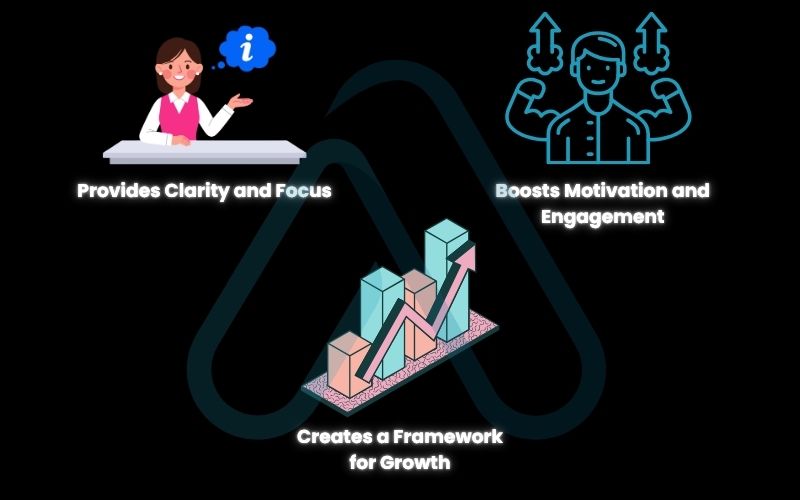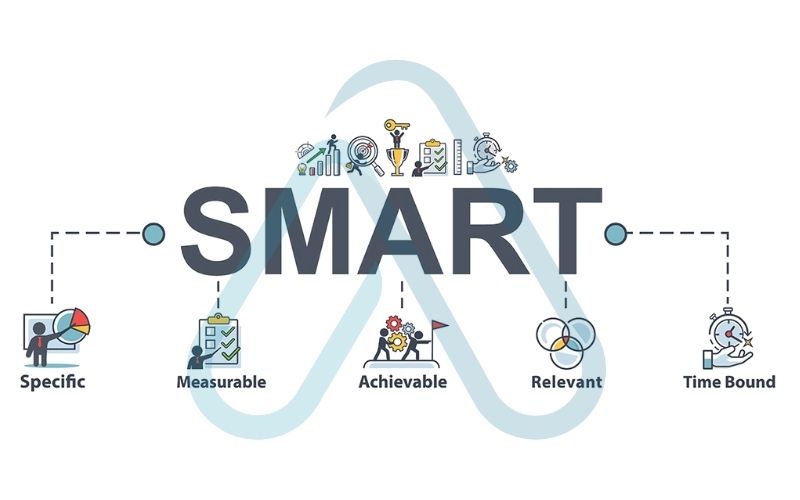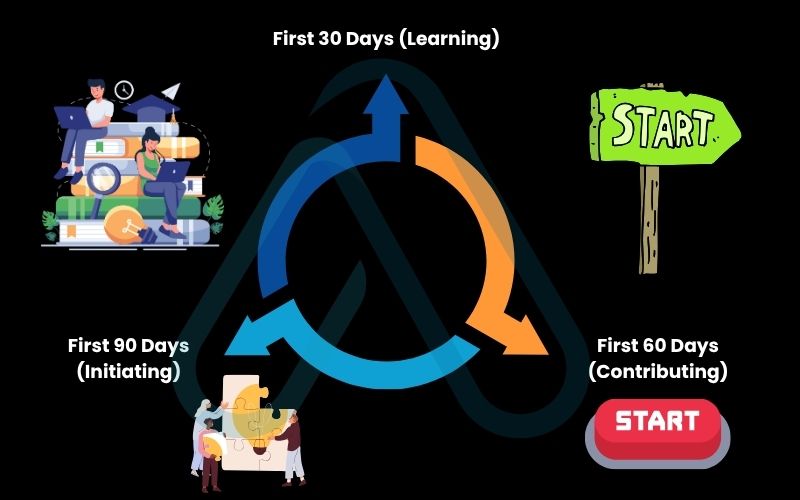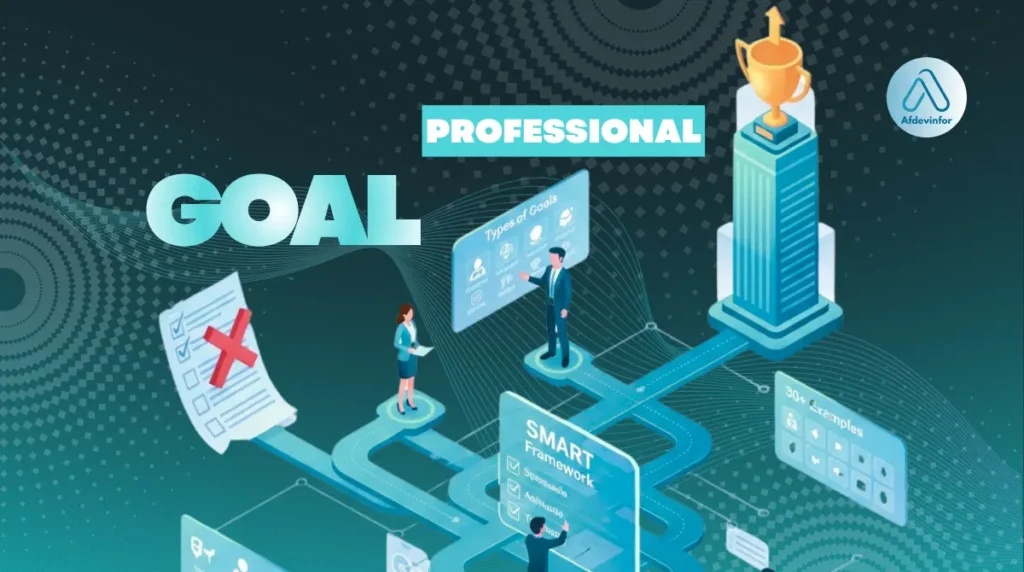Feeling adrift in your career? I’ve been there. It’s a common feeling when you lack a clear destination. A well-defined professional goal is your compass, but it’s more than just a to-do list item. To truly understand what is a professional goal, we have to look beyond the simple act of setting targets. It’s about creating a strategic vision for your career that motivates and directs your daily actions.
This guide is designed to move you from uncertainty to clarity. We’ll explore the definition of a professional goal, look at powerful examples, learn frameworks like SMART, identify common mistakes, and, most importantly, develop a critical-thinking approach to ensure the goals you set are genuinely right for you.
1. What is a professional goal, really?
A professional goal is more than just a milestone you hope to reach someday; it’s a clear, intentional direction for where you want your career to go and why. Instead of being a vague wish like “get promoted,” a true professional goal defines the specific skills you want to build, the impact you want to make, and the kind of work you want to grow into.
It acts as a compass that guides your decisions, helps you stay focused, and keeps your long-term vision aligned with the career you genuinely want. A professional goal is a specific, measurable statement that outlines a desired outcome in your career, acting as a roadmap to guide your skill development, performance, and long-term growth.
2. Why professional goals are your career’s non-negotiable compass
Understanding why professional goals are important is the first step toward committing to them. In my experience, I’ve seen firsthand that professionals with clear objectives are not only more successful but also more fulfilled in their roles. They provide the ‘why’ behind the daily grind.
Here are the core benefits of setting clear career development objectives:
- Provides Clarity and Focus: Goals cut through the noise of daily tasks. They help you prioritize what’s important versus what’s merely urgent, ensuring your efforts are always aligned with your long-term vision.
- Boosts Motivation and Engagement: Having a target to aim for significantly increases workplace motivation. When you can see how your work contributes to a larger personal or organizational objective, your engagement and job satisfaction soar.
- Creates a Framework for Growth: Goals make your career progress measurable. Instead of just ‘working hard,’ you’re actively building skills and achieving milestones that you can point to during performance reviews or when seeking new opportunities.

3. Types and real-world examples about the anatomy of an effective goal
Not all goals are created equal. Breaking them down into different types can help you build a well-rounded and strategic career plan. Here, I’ll cover the most common categories and provide real-world examples to help you understand what a professional goal looks like in practice.
3.1. Short-term vs. long-term goals
The most fundamental way to categorize goals is by their timeframe. Your short-term career goals should be the building blocks for your long-term professional growth, creating a clear path from where you are now to where you want to be in the future.
Here is a simple comparison of the two:
| Criteria | Short-Term Goals | Long-Term Goals |
| Timeframe | Typically under one year. | Typically 3-5 years or more. |
| Scope | Focused on immediate skills or projects. | Focused on major career shifts or achievements. |
| Purpose | Act as stepping stones; provide quick wins. | Define your ultimate career destination. |
Here are some examples:
| Goal | Category | Why it works |
| Complete a Google Analytics certification within the next three months. | Short-Term, Skill-Based | It’s a specific, time-bound objective that adds a tangible skill to your resume, supporting a long-term goal of becoming a digital marketing manager. |
| Attain a senior management position within my current company in five years. | Long-Term, Performance-Based | This sets a clear, ambitious destination. The short-term goals to support this might include leading a successful project, mentoring a junior colleague, and completing leadership training. |
3.2. Skill-based vs. performance-based goals: What you learn vs. what you achieve
A balanced career plan includes both learning new things and achieving concrete results. Skill-based goals focus on acquiring new competencies, while performance-based goals are centered on hitting specific metrics or key performance indicators (KPIs). Effective skill-building strategies are often the foundation for hitting ambitious performance targets.
Consider these contrasting examples:
| Goal | Category | Why it works |
| Learn the fundamentals of Python for data analysis by completing an online course by the end of Q3. | Skill-Based | This goal is focused entirely on acquiring a new, marketable skill that can be applied to future tasks. |
| Increase qualified sales leads generated through my content marketing efforts by 15% over the next quarter. | Performance-Based | This goal is tied directly to a business outcome and can be measured with hard data. The skill-based goals supporting this might include learning SEO or advanced social media advertising. |
3.3. Leadership and management goals
For those aspiring to or currently in leadership roles, goals often shift from individual contribution to team enablement and strategic impact. These goals focus on developing others, improving processes, and steering the team toward success.
Here are a few targeted examples of what a professional goal for a leader might be:
- Successfully mentor a junior team member, helping them achieve a promotion within one year.
- Implement a new project management workflow that reduces team project delivery times by 10% within six months.
- Improve my public speaking skills by presenting at two industry conferences over the next year.
4. The SMART framework with a powerful tool, not a magic formula
You’ve probably heard of SMART goals, and for good reason. It’s a simple, effective framework for adding structure to your ambitions. While I believe it’s a foundational tool, it’s not the complete picture, as we’ll discuss later. Answering the question ‘What makes a professional goal effective?’ often starts with making it SMART. Crafting SMART professional goals turns vague wishes into actionable plans.
Here’s how to apply the framework:
- Specific: Your goal must be clear and well-defined. Instead of ‘Get better at sales,’ try ‘Increase my closing rate on enterprise-level accounts.’
- Measurable: You need to be able to track your progress. The ‘Measurable’ component directly answers, ‘How can I track and measure my professional goals?’ For the sales goal, this could be ‘Increase my closing rate from 20% to 25%.’
- Achievable: Your goal should be realistic given your current resources and constraints. A 5% increase is challenging but possible; a 50% increase might be setting yourself up for failure.
- Relevant: The goal must align with your broader career objectives and the company’s priorities. Does increasing your closing rate help you earn a promotion or contribute to the team’s success?
- Time-bound: Every goal needs a deadline to create a sense of urgency. ‘Increase my closing rate from 20% to 25% by the end of Q4.’
Let’s see the transformation in action:
- Before: I want to be a better public speaker.
- After (SMART Goal): I will improve my public speaking skills by joining Toastmasters and delivering three prepared speeches over the next six months, with the goal of gaining the confidence to present at our next departmental meeting.

5. Common pitfalls and how to avoid them in goal setting
Setting a goal is easy; setting the *right* goal and sticking to it is hard. Over the years, I’ve identified several common goal setting mistakes that can derail even the best intentions. Recognizing these pitfalls is the first step to avoiding them.
5.1. The trap of vague ambitions
The Pitfall: Setting goals like ‘improve my skills’ or ‘get a promotion’ is like trying to navigate without a map. They lack the clarity needed for action. This is the most common mistake I see, and it directly undermines the ‘Specific’ and ‘Measurable’ principles of the SMART framework. Without a clear target, you have no way of knowing what to do next or when you’ve succeeded.
The Solution: Always force yourself to define what ‘better’ or ‘more’ looks like. Instead of ‘improve my skills,’ specify the skill: ‘Learn advanced functions in Microsoft Excel to automate my weekly reporting process.’
5.2. Setting unrealistic goals and avoiding burnout
Setting unrealistic goals is one of the fastest ways to drain your motivation and push yourself toward burnout. When your ambition isn’t grounded in what’s realistically achievable, even the most exciting career plans can turn into sources of stress.
Many professionals fall into this trap without realizing it, especially when they’re eager to advance quickly or feel pressured to meet high expectations. This makes it harder to maintain momentum and increases the risk of mental and physical exhaustion.
The Pitfall:
Ambition is great, but setting impossibly high goals can lead directly to frustration, anxiety, and burnout. When a goal feels out of reach, motivation plummets. This is often a failure of the ‘Achievable’ component of SMART goals.
The Solution:
Break down your massive long-term goal into smaller, achievable short-term goals. If your goal is to become a CTO, your first step isn’t to apply for the job; it’s to master a new programming language or lead a small project team. This builds momentum and confidence without overwhelming you.
According to a 2023 Deloitte survey, 77% of professionals have experienced burnout at their current job, often fueled by an overwhelming workload and pressure to perform. Realistic goal setting is a key defense.
5.3. Forgetting to align goals with personal values
Forgetting to align your goals with your personal values is an easy mistake to overlook, especially when you’re focused on moving your career forward as quickly as possible. But when your goals don’t reflect what truly matters to you, even well-planned milestones can leave you feeling unfulfilled.
This disconnect often shows up later as frustration, low motivation, or a sense that your career is progressing in the wrong direction.
The Pitfall:
This is the most subtle but critical mistake. You can set a perfectly SMART goal that your manager loves, but if it doesn’t align with what you truly want from your life and career, you’ll struggle to stay motivated. Chasing a promotion you think you *should* want, rather than one you genuinely desire, is a recipe for unhappiness.
The Solution:
Before you finalize a goal, ask yourself some tough questions. Does this goal move you toward a career you genuinely enjoy? Does it align with your desired work-life balance? A goal is only powerful if it’s connected to your personal ‘why’.
6. Are you setting the right professional goal?
To help you think more critically about your objectives, I’ve designed this simple decision-making flowchart. Use this sequence of questions to test the strength and relevance of any potential goal and ensure you’re setting the right career development objectives.
Start with a potential goal and work through these steps:
What is the core outcome? (Be specific: 'learn a skill,' 'achieve a metric,' 'lead a project.')
- If you can’t define it clearly: Your goal is too vague. Go back to the ‘Specific’ principle of SMART.
- If you can define it: Move to the next question.
Is this goal aligned with your long-term (3-5 year) career vision?
- If no: Re-evaluate. Is this goal a distraction, or has your long-term vision changed? Be honest with yourself.
- If yes: Great! It’s strategically relevant. Move on.
Is this goal aligned with your team's or company's current priorities?
- If no: This goal might be difficult to get support for. Can you reframe it to show its value to the organization, or should you focus on something else for now?
- If yes: Excellent. You’re more likely to get the resources and backing you need.
Can you define at least three concrete, first-step actions you can take in the next month?
- If no: The goal might be too large or abstract. Break it down into smaller, more manageable sub-goals.
- If yes: You have a clear path to begin. This goal is actionable and ready to pursue.
7. How your role and company culture impact your goals
A goal doesn’t exist in a vacuum. Its success is heavily influenced by your work environment, including your company’s culture, your department’s priorities, and current industry trends. Ignoring this context is a mistake I see many ambitious professionals make. For example, a goal to rapidly innovate is fantastic, but if your company culture is highly risk-averse, your first goal should probably be to build consensus for small, incremental changes.
Before setting your goals, ask these questions about your workplace context:
- What does my manager’s success look like? How can my goals support theirs?
- What are the top 3 priorities for my department this year?
- Does my company culture reward innovation and risk-taking, or stability and consistency?
- What skills are becoming more valuable in my industry?
7.1. Setting effective goals in a new job
When you start a new role, your primary goal is to learn and integrate successfully. Setting professional goals for a new job should focus on observation, relationship-building, and delivering an early win. It’s wise to listen more than you speak and understand the culture before setting ambitious long-term goals.
Here is a simple 30-60-90 day plan template I recommend for anyone starting a new position:
- First 30 Days (Learning): My primary goal is to meet my team members, understand the key processes and systems, and clarify the expectations for my role. I will aim to complete all onboarding training and successfully handle my initial responsibilities.
- First 60 Days (Contributing): My goal is to become more independent in my core tasks and to identify one small process improvement or take on a small project. I will actively seek feedback from my manager to ensure I’m on the right track.
- First 90 Days (Initiating): By now, my goal is to be fully integrated into the team. I will deliver my first significant ‘win’, completing a project or solving a recurring problem and work with my manager to set my first official performance goals for the next quarter.

8. Adjusting your goals when circumstances change
One of the most important lessons I’ve learned is that professional goals are not set in stone. The business world is dynamic; projects get canceled, companies pivot, and personal priorities change. Treating your goals as rigid commands leads to frustration when reality inevitably intervenes. The key is to be agile, to review and adjust your goals regularly.
Here’s a simple framework for recalibrating your goals without feeling like you’ve failed:
- Schedule Quarterly Reviews: Set a recurring calendar reminder every three months to review your professional goals. This creates a dedicated time for reflection.
- Assess Relevancy: For each goal, ask: ‘Is this still the most important thing for me to be working on?’ Consider any changes in your role, team priorities, or personal interests.
- Communicate Changes: If you need to adjust a goal, especially one you share with your manager, communicate the change proactively. Explain why the pivot is necessary and propose a new, more relevant goal.
- Celebrate Pivots: View adjusting a goal not as a failure, but as a strategic decision. You’re adapting to new information, which is a sign of professional maturity and agility.
9. FAQs about what is a professional goal?
Here are quick answers to some of the most common questions I get about setting professional goals.
What makes a professional goal effective?
An effective goal is specific, measurable, and achievable (SMART), aligned with your personal vision and company needs, and flexible.
How many professional goals should I have at once?
Focus on 2-3 significant goals at a time; this prevents you from being spread too thin and allows for meaningful progress.
How can I track and measure my professional goals?
Use a tool you’ll stick with (like Trello or a journal) and track progress via regular check-ins with your manager or mentor.
Should I share my professional goals with my manager?
Yes; it ensures alignment, allows them to provide support and resources, and makes them aware of your aspirations.
10. Final thoughts: Your goals, your career, your design
We’ve covered a lot of ground, moving from the basic definition of a professional goal to the nuanced art of setting objectives that are not only SMART but also context-aware, personally meaningful, and adaptable. If there’s one thing I want you to take away, it’s that effective goal setting is a dynamic process of strategic thinking, not a static, one-time task. It requires self-reflection, environmental awareness, and the agility to adjust as you and the world around you change.
Here are the most critical takeaways:
- A great professional goal is more than a task; it’s a clear, motivating statement that directs your career.
- Use frameworks like SMART as a starting point, but don’t forget to align your goals with your personal values and your company’s context.
- Regularly review and adjust your goals. Adaptability is a professional superpower.
Now, you have the tools to move from aimless effort to intentional progress. Your career is yours to design.
For more in-depth guides on professional development and workplace productivity, I encourage you to explore our Career Development categories here on Afdevinfo.
Glossary of key terms
| Abbreviation | Full Term | Meaning |
| SMART | Specific, Measurable, Achievable, Relevant, Time-bound | A goal-setting framework used to guide the creation of clear and actionable objectives. |
| KPI | Key Performance Indicator | A quantifiable measure used to evaluate the success of an organization, employee, or project in meeting objectives. |


